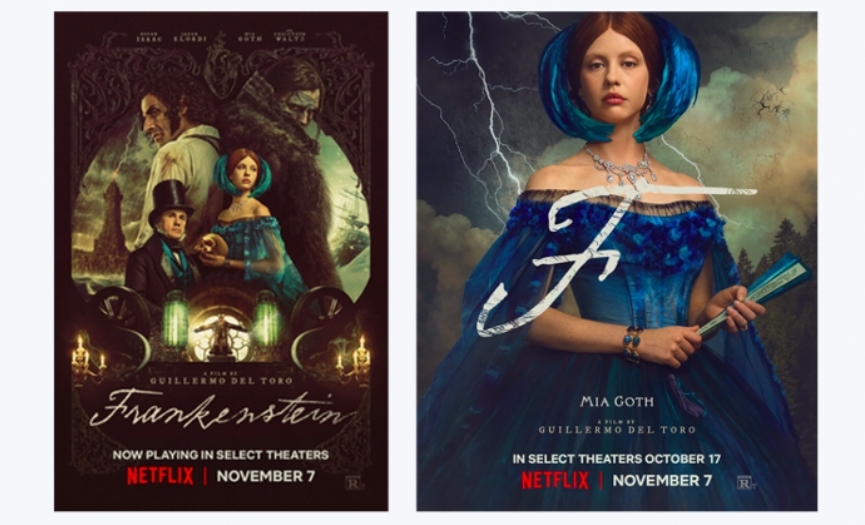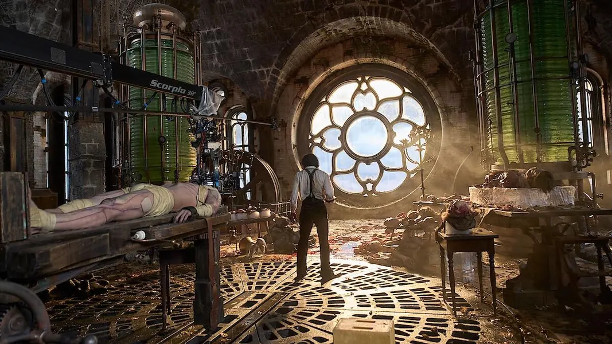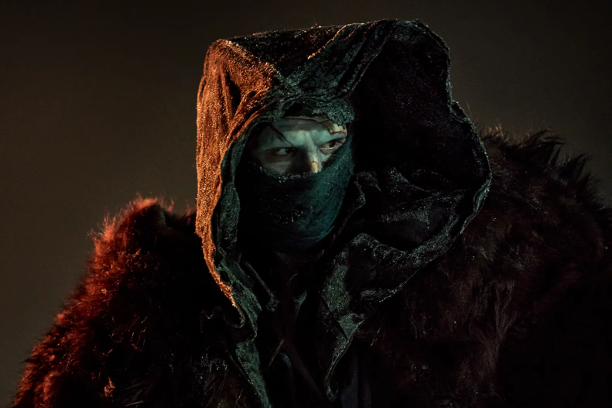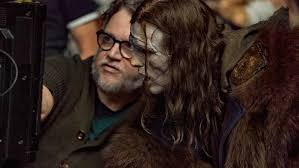
Frankenstein (2025) - A Nightmare Come True

By Bessy ADUT
Frankenstein (2025) is one of my favorites in the horror genre, along with Dracula. I have always loved the gothic genre. In fact, when I was graduating from Istanbul Bilgi University, Film & Television Department, I wrote my thesis on the gothic genre and the famous fairy tale Blue Beard. I even created a thesis film adaptation called Forbidden Door. So, seeing this genre making a successful comeback in del Toro’s Frankenstein was a real delight. It felt like a guilty pleasure to experience and work through. I felt the Monster deeply, especially in intimate moments like the scene where Frankenstein gives Mia Goth’s character a leaf and she gracefully accepts it: “A leaf for me? Thank you.” That moment felt symbolic; this movie itself was a leaf to us. Thank you, del Toro.
Frankenstein is a 2025 American gothic drama written, produced, and directed by Guillermo del Toro, inspired by Mary Shelley’s 1818 novel. The film stars Jacob Elordi (as the Creature), Oscar Isaac, Mia Goth, and Christoph Waltz, and explores ambition, loneliness, and the monstrous cost of creation.

The movie premiered at the 82nd Venice International Film Festival on August 30, 2025, opened in select theaters on October 17, and launched globally on Netflix on November 7. It has already earned strong critical praise.
Gothic Romanticism & Influences
Frankenstein is steeped in Gothic romanticism; dark, emotional, lush, and haunted. It evokes films like del Toro’s Crimson Peak, Neil Jordan’s Interview with the Vampire, and Coppola’s Bram Stoker’s Dracula.

Del Toro has said that for him, Frankenstein was almost religious. Raised Catholic, he never quite understood saints until he saw Boris Karloff on screen and suddenly understood what a messiah or martyr could look like. He waited decades to make the film “at a scale that you could reconstruct the whole world.”
He drew on a rich cinematic lineage: James Whale’s 1931 Frankenstein and its 1935 sequel Bride of Frankenstein, as well as emotionally charged classics like Hitchcock’s Rebecca, Wyler’s Wuthering Heights, Mankiewicz’s Dragonwyck, and Charles Frank’s Uncle Silas. This mix gives the film both gothic elegance and emotional resonance.

Performances & Characters
What really resonated with me was the second half of the film, when we see the story from the Creature’s perspective. His longing for acceptance and his suffering become deeply moving. This perspective reinforces a central theme: The real monsters are often the humans, not their creations.

Mia Goth is phenomenal, portraying two very different characters; Lady Elizabeth Harlander, William’s fiancée, and Baroness Claire Frankenstein, Victor’s late mother. Her transformation is so complete that at times I didn’t even recognize her.

Jacob Elordi, as the Creature, brings intensity, vulnerability, and depth. He described the story as “very European, but told through a very Latin-American, Mexican, Catholic point of view,” which adds cultural richness and passion.

Visuals & Music
Artistically, Frankenstein is stunning. The cinematography is haunting and precise, the production design and costumes richly textured and immersive.
The score by Alexandre Desplat is one of the film’s emotional pillars. He said: “Guillermo’s cinema is very lyrical, and my music is rather lyrical too. So I think the music of Frankenstein will be something very lyrical and emotional. I’m not trying to write horrific music.” The result is poetry in sound, enhancing the Monster’s sadness, Victor’s guilt, and the film’s gothic beauty.

Themes & Resonance
The heart of the film is the idea that the real monsters are human. It is not just a story of creation but a meditation on loneliness, guilt, and playing god. Del Toro’s personal passion and spiritual perspective are woven throughout, giving the story depth and gravitas.
Why It Might Be an Awards Contender
Given the film’s artistry, performances, design, music, and storytelling, I expect Frankenstein to be a strong awards contender. It combines craft, emotion, and bold reinterpretation of a timeless story.

Final Thoughts
Frankenstein is visually mesmerizing, emotionally rich, and deeply thoughtful. Del Toro’s reimagining is personal and timeless. This film truly feels like a nightmare come true in the most beautiful way.
I also love the final quote, which resonates deeply:
“The heart will break and yet brokenly live on.” This line from Lord Byron’s Childe Harold’s Pilgrimage mirrors the film’s bittersweet, hopeful ending. It reflects the Creature’s resilience and the idea that even in brokenness, life endures.
🎬 Watch the trailer: Frankenstein (2025) Official Trailer

Fun Facts: Frankenstein — A Dream Decades in the Making
- Del Toro has wanted to make this film since 2007, calling it the one project he “would kill to make.”
- He envisioned the film as a Miltonian tragedy, drawing on epic, mythic stakes.
- He praised Frank Darabont’s 1994 Mary Shelley’s Frankenstein screenplay as “pretty much perfect.”
- Del Toro has long been fascinated by the Monster, inspired by Boris Karloff and his childhood imagination.
- In 2016, he reflected on the challenge and risk: “I dream I can make the greatest Frankenstein ever… then if you make it, you’ve made it… That’s the tragedy of a filmmaker… Whether it’s great or not, it’s done… You landed a 10 or 6.5, but you were at the Olympics already, and you were judged.”
- He believes universal myths allow for personal interpretation: “Any interpretation is equally faithful if done with sincerity, power, and personality.”
- His influences include Whale’s Frankenstein and Bride of Frankenstein, along with gothic classics like Rebecca, Wuthering Heights, Dragonwyck, and Uncle Silas.
- The score by Alexandre Desplat is lyrical, emotional, and haunting, complementing the gothic tone perfectly.
Related News











